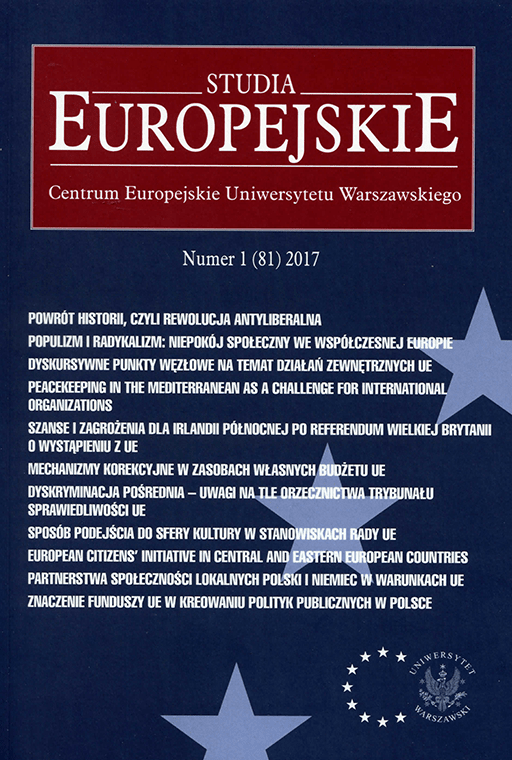
ISSUE: 1/2017
- Volume 81
- Number 1
- 2017
Subscribe NEWSLETTER
Studia Europejskie –
Studies in European Affairs
ISSN: 1428-149X
e-ISSN: 2719-3780
License
Articles published in the journal are under a Creative Commons Attribution – Non Commercial – No Derivatives 4.0 International License
Sposób podejścia do strefy kultury w stanowiskach Rady Europejskiej
Approach to Culture in Positions of the Council of the European Union
Abstract
This article attempts to explain the understanding of culture which form the basis of the EU’s cultural policy as well as to present changes
in that regard occurring along with the development of this policy. The research material consisted of common positions of the EU member
states adopted during meetings of the Council of the European Union. The research was done using qualitative content analysis. The most
general conclusion from the research is that the basis of the EU’s cultural policy since the beginning of the researched period have consisted
of two different approaches to culture in the EU: cultural unity and cultural diversity. Moreover, the creators of the EU’s cultural policy understood the role of culture in the integration process in four ways: as a non-instrumental value, a sociocreative factor, an economic factor as well as a factor enhancing the external relations of the EU. During the researched period we observed certain changes regarding the approach towards culture. They involved either changes within the already existing ideas or creating new concepts concerning the cultural sphere.
References
Bhabha H., Introduction, w: The Nation and Narration, red. H. Bhabha, Routledge, London 1990.
Delanty G., Redefi ning Political Culture in Europe Today: from Ideology to the Politics of Identity and Beyond, w: Political Symbols, Symbolic Politics. European Identities in Transformation, red. U. Hedetoft, Ashgate, Aldershot–Brookfi eld USA–Singapore–Sydney 1998.
Edensor T., Tożsamość narodowa, kultura popularna i życie codzienne, tłum. A. Sadza, Wydawnictwo Uniwersytetu Jagiellońskiego, Kraków 2004.
Gellner E., Narody i nacjonalizm, tłum. T. Hołówka, PIW, Warszawa 1991.
Gutmann A., Introduction, w: Multiculturalism. Examining the Politics of Recognition, Princeton University Press, Princeton, New Jersey 1994.
Jurkiewicz-Eckert D., Od „wspólnego dziedzictwa kulturowego” do „wspólnego obszaru kulturowego”. O nowych kierunkach debaty wokół przyszłości kultury w Unii Europejskiej, „Studia Europejskie”, nr 3/2003, s. 81–97.
Jurkiewicz-Eckert D., Od Traktatu o Unii Europejskiej do Europejskiej Agendy dla Kultury – narodziny i rozwój polityki kulturalnej UE, “Studia Europejskie”, nr 1/2015, s. 65–89.
Littoz-Monnet A., Encapsulating EU Cultural Policy into the EU’s Growth and Competiveness Agenda: Explaining the Success of a Paradigmatic Shift in Brussels, w: Cultural Governance and the European Union. Protecting and Promoting Cultural Diversity in Europe, red. E. Psychogiopoulou, Palgrave Macmillan, Basingstoke 2015, s. 25–36.
Schreier M., Qualitative Content Analysis in Practice, SAGE, Londyn 2012.
Shore C., ‘In uno plures’ (?) EU Cultural Policy and the Governance of Europe, “Cultural Analysis”, nr 5/2006, s. 7–26.
Smith A.D., Nations and Nationalism in a Global Era, Polity Press, Cambridge 2002.
Smith A., Nationalism and Modernism. A Critical Survey of Recent Theories of Nations and Nationalism, Routledge, London–New York 2003.
Language: Polish
Pages: 159-176
How to Cite:
Harvard
Burgoński, P. (2017) "Sposób podejścia do strefy kultury w stanowiskach Rady Europejskiej". Studia Europejskie – Studies in European Affairs, 1/2017, pp. 159-176.